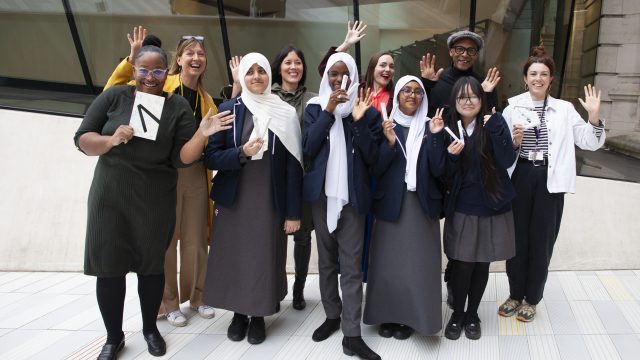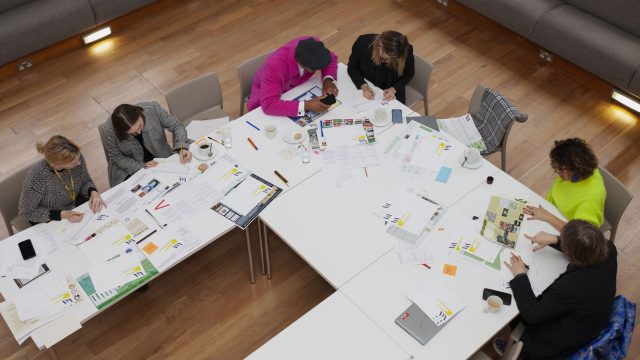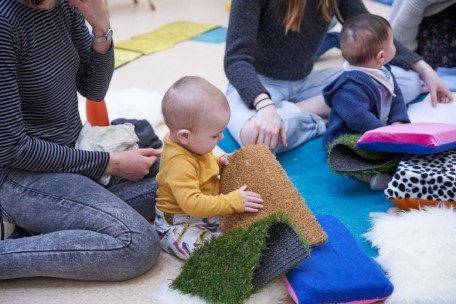Among the most historic – and historical – treasures in the V&A’s Medieval and Renaissance Galleries are four stained glass panels from a series depicting the rulers of the Burgundian Netherlands, together with angels bearing coats-of-arms, originally from the windows of the Chapel of the Holy Blood in Bruges. The V&A panels depict Mary, Duchess of Burgundy, her husband Maximilian of Habsburg, Archduke of Austria and later Holy Roman Emperor, their son Philip the Handsome and his wife Joanna of Castile (sister of Henry VIII’s queen, Katherine of Aragon).

Philip the Fair, Flanders, Belgium, Panel of Clear and Coloured glass with Painted Details, Medieval and Renaissance Galleries, Room 10, Case WS , Mus Ref: C.441-1918 © Victoria and Albert Museum, London
They are a reminder of the important and complex part played by the Netherlands in the political history of Europe around 1500. This region – roughly equivalent to modern Belgium, but also comprising parts of north eastern France, the modern Netherlands, and Luxembourg – immensely wealthy and culturally important, was ruled from the late 14th century by the Dukes of Burgundy, members of the French royal family, the Valois. Mary of Burgundy was the last of this line; after her untimely death aged 24 in 1482, brought about by falling from her horse while hunting, her husband Maximilian, a member of the Austrian family of Habsburg, ruled as regent for their young son, the future Philip the Handsome, although his right to rule was fiercely contested by feisty cities such as Bruges. It is thought that the windows were commissioned by Maximilian as a reminder of the legitimacy of the Habsburg claim to be hereditary rulers of the region – a claim that proved to be successful and far-reaching: the son of Philip the Handsome and Joanna of Castile (also known as Joanna the Mad, as she lost her mind due to Philip’s early death), and Mary and Maximilian’s grandson, was the future Holy Roman Emperor Charles V, who inherited Spain through his mother, and the Burgundian Netherlands and Austria through his father, making the Habsburgs the most powerful rulers in Europe. Netherlands eventually passed to Spanish rule.

Maximilian of Habsburg, Flanders, Belgium, Panel of Clear and Coloured glass with Painted Details, Medieval and Renaissance Galleries, Room 10, Case WS , Mus Ref: C.438-1918 © Victoria and Albert Museum, London
Still a sacred site today, housing a relic of Christ’s blood, the Chapel of the Holy Blood was one of the most prestigious churches in late medieval Bruges; although founded in the twelfth century, it was substantially remodelled in 1482. It stands next to the town hall, the centre of government. It was therefore an astute choice on Maximilian’s part for this display of Burgundian-Habsburg propaganda. The series began with Philip the Bold, the first Valois Duke of Burgundy, and comprised seven pairs of figures altogether, ending with Philip and Joanna, and with heraldic devices proclaiming the family lineage.

Arms of Isabella of Bourbon, Flanders, Belgium, Panel of Clear and Coloured glass with Painted Details, Medieval and Renaissance Galleries, Room 10, Case WS , Mus Ref: C.443-1918 © Victoria and Albert Museum, London
Testifying to their enduring association with dynastic rule, the windows were removed in 1795 when the (republican) French revolutionary commissioners dismantled the Chapel of the Holy Blood. The glass from the chapel was sold, around 1800, to an English collector in Norwich, but it is not clear if this was all the glass or only some of it; the surviving panels resurfaced in London in 1911 and were purchased by the V&A in 1918.
There are payments in the Holy Blood archive for glazing the chapel in 1496 and 1500. As Philip and Joanna married in 1496 it is tempting to see this as the possible date for these dynastic windows. Philip is shown holding a carnation, associated with love and often seen in betrothal imagery in this period, while Joanna wears her hair loose, the mark of a bride.

Joanna of Castile, Flanders, Belgium, Panel of Clear and Coloured glass with Painted Details, Medieval and Renaissance Galleries, Room 10, Case WS , Mus Ref: C.442-1918 © Victoria and Albert Museum, London
All the figures are magnificently dressed, but additionally, Maximilian’s costume bristles with details proclaiming his power and his right to rule. He is shown armed, wearing the Archducal cap and the chain of the Burgundian Order of the Golden Fleece; over his armour his tunic is decorated with the arms of Burgundy and of the Habsburgs, and the border of his ermine-lined mantle is embroidered with two initial letters ‘M’ joined by love-knots, signifying his union with Mary of Burgundy.

Mary of Burgundy, Flanders, Belgium, Panel of Clear and Coloured glass with Painted Details, Medieval and Renaissance Galleries, Room 10, Case WS , Mus Ref: C.439-1918 © Victoria and Albert Museum, London
She herself wears the steeple headdress, or hennin, fashionable at the time of her death in the 1480s, and holds a small lapdog (a similar dog, perhaps a favourite pet, or perhaps simply a fashionable accessory, appears in a miniature depicting her at prayer in the Hours of Mary of Burgundy, now in Vienna). The identity of the artist responsible for the portraits is not known. Bruges was a centre for painting on panel and on cloth, and it is probable that the cartoons for the windows were produced by one of the city’s many panel painters, based on existing portraits of these personages.
“Twenty Objects for Twenty Years” is a series of articles written by Paula Nuttall, Director of the Late Medieval to Early Renaissance Year Course, exploring some of her favourite pieces in the V&A’s extensive Renaissance collections along with contributions from students and museum staff. You can find the rest of the series along with other posts from the Learning Department at the V&A on their blog.


